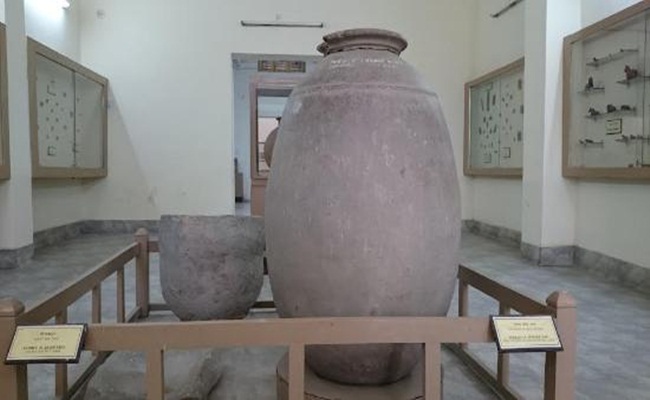Udaipur, the “City of Lakes,” is renowned for its royal palaces, shimmering lakes, and rich history. Among its many cultural treasures lies Ahar Museum, a hidden gem that offers a glimpse into the ancient heritage of Rajasthan. Nestled amidst the serenity of Udaipur, this museum is a must-visit for history buffs and first-time visitors eager to explore the region’s lesser-known historical landmarks.
Location
Ahar Museum is located in the small village of Ahar, just 3 kilometers east of Udaipur city center. This peaceful site is situated near the renowned Ahar Cenotaphs, a collection of royal memorials that add to the historical significance of the area.
Address: Ganapati Nagar, Udaipur, Rajasthan 313001
GPS Coordinates: 24.5876° N, 73.7305° E
How to Reach
By Air:
The nearest airport is Maharana Pratap Airport (Udaipur Airport), located about 22 km away. From the airport, you can hire a taxi to reach the museum.
By Train:
The closest railway station is the Udaipur City Railway Station, approximately 5 km from the museum. Autorickshaws and taxis are readily available to take you to Ahar Museum.
By Road:
Udaipur is well-connected by road to major cities like Jaipur, Delhi, and Ahmedabad. Ahar Museum is easily accessible by local buses, taxis, or autorickshaws from any part of the city.
Best Option for Local Transport:
Hire an auto-rickshaw or a two-wheeler for a budget-friendly ride to Ahar Museum.
History of Ahar Museum
Ahar’s legacy dates back over 4,000 years, with its origins rooted in the Ahar-Banas Civilization, one of India’s oldest archaeological sites. The museum was established to preserve and showcase artifacts unearthed during excavations in and around the region. These findings provide fascinating insights into the Chalcolithic period (2000-1500 BCE) and the ancient Mewar kingdom.
Over the centuries, Ahar became an important site for Mewar rulers, serving as a royal cremation ground for over 250 cenotaphs of the Maharanas. The museum was set up to complement the Ahar Cenotaphs and houses an impressive collection of historical artifacts discovered at the site.
Attractions at Ahar Museum
Archaeological Artifacts:
Ahar Museum showcases a remarkable collection of over 1,500 artifacts, including terracotta figurines, pottery, tools, and seals from the Chalcolithic period. These items are a window into the lifestyle, trade, and culture of ancient civilizations.
Iron and Copper Implements:
View ancient tools and weapons made of copper and iron, reflecting the advanced metallurgy skills of the Ahar-Banas Civilization.
Stone Sculptures:
The museum houses beautifully carved statues of Hindu and Jain deities, dating back to the 8th-12th centuries. The intricate detailing of these sculptures highlights the artistic brilliance of that era.
Coins and Inscriptions:
Explore ancient coins, inscriptions, and seals, which reveal information about trade, religion, and administration in Mewar’s history.
Ahar Cenotaphs:
Adjacent to the museum lies the famous Ahar Cenotaphs, a cluster of elegant marble structures built to commemorate the royal family of Mewar. The striking architecture, with its domes and intricate carvings, is a photographer’s delight.
Interesting Facts About Ahar Museum
Prehistoric Roots: The Ahar-Banas Civilization predates the Indus Valley Civilization and is considered one of the earliest urban settlements in India.
Royal Cremation Ground: The cenotaphs in Ahar are dedicated to 19 kings of Mewar, including Maharana Amar Singh and Maharana Sangram Singh.
Chalcolithic Legacy: The museum houses one of the most extensive collections of Chalcolithic artifacts in India.
Unique Cenotaph Design: The cenotaphs are built with distinct Rajasthani architecture, combining Hindu and Mughal styles.
Best Time to Visit
The best time to explore Ahar Museum and Udaipur is during the winter months from October to March, when the weather is pleasant. Avoid visiting during the peak summer months (April to June), as the heat can be intense.
Visitor Information
Timings: Open daily from 10:00 AM to 4:30 PM (Closed on Fridays and public holidays).
Entry Fee:
Adults: ₹20
Children: ₹10
Additional charges for cameras.
Duration of Visit: 1-2 hours
Tips for First-Time Visitors
Combine Your Visit: Pair your trip to Ahar Museum with a visit to the nearby Ahar Cenotaphs for a complete historical experience.
Wear Comfortable Shoes: You’ll need to walk a bit to explore the museum and cenotaph complex.
Carry Water: Stay hydrated, especially during the summer.
Respect the Heritage: Avoid touching or damaging the artifacts and structures.
Hire a Guide: A knowledgeable guide can enhance your experience with detailed stories and insights about the exhibits.
Why Visit Ahar Museum?
Ahar Museum offers a unique journey into the ancient past of Rajasthan, showcasing artifacts that connect visitors with the region’s prehistoric and medieval eras. Whether you’re a history enthusiast, an architecture lover, or simply looking to experience a quieter side of Udaipur, Ahar Museum is a destination worth exploring.
So, next time you’re in Udaipur, don’t miss this treasure trove of history waiting to be discovered!

